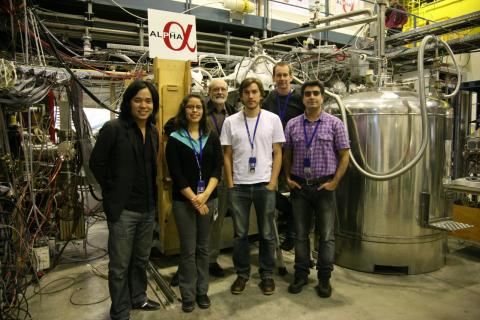
Canadian researchers instrumental in game-changing antimatter study
(Vancouver, BC) – Science fiction is fast approaching science fact as researchers are progressing rapidly toward “bottling” antimatter. In a paper published online today by the journal Nature Physics, the ALPHA experiment at CERN, including key Canadian contributors, reports that it has succeeded in storing antimatter atoms for over 16 minutes. While carrying around bottled antimatter like in the movie Angels and Demons remains fundamentally far-fetched, storing antimatter for long periods of time opens up new vistas for scientists struggling to understand this elusive substance. ALPHA managed to store twice the antihydrogen (the antimatter partner to normal hydrogen) 5,000 times longer than the previous best, setting the stage, for example, to test whether antihydrogen and normal hydrogen fall the same way due to gravity.
Lead author Makoto Fujiwara, TRIUMF research scientist, University of Calgary adjunct professor, and spokesperson of the Canadian part of the ALPHA team said, “We know we have confined antihydrogen atoms for at least for 1,000 seconds. That’s almost as long as one period in hockey! This is potentially a game changer in antimatter research.”
Antimatter remains one of the biggest mysteries of science. At the Big Bang, matter and antimatter should have been produced equally, but since they destroy each other upon contact, eventually nothing should have remained but pure energy (light). However, all observations suggest that only the antimatter has vanished. To figure out what happened to “the lost half of the universe,” scientists are eager to determine if, as predicted, the laws of physics are the same for both matter and antimatter. ALPHA uses an analogue of a very well-known system in physics, the hydrogen atom (one electron orbiting one proton), and testing whether its antimatter twin, antihydrogen (an antielectron orbiting an antiproton), behaves the same. But to study something one must hold onto it long enough.
Fujiwara asks, “Does antimatter shine in the same colour as matter? Does it experience the gravity in the same way as matter?” These are still very difficult experiments, and they will take long and hard work, but this new result is a very important step. Now experiments will be about 10,000 times less difficult than before!” Explained ALPHA spokesperson Jeffrey Hangst of Aarhus University, “This would provide the first-ever look inside the structure of antihydrogen - element 1 on the anti-periodic table.”
Antihydrogen atoms were first made in large quantities at CERN eight years ago, but can’t be stored conventionally since antiatoms touching the ordinary-matter walls of a bottle would instantly annihilate. The ALPHA collaboration succeeded by developing a sophisticated “magnetic bottle” using a state-of-the-art superconducting magnet to suspend the antiatoms away from the walls, last year demonstrating definitive proof of antihydrogen atom capture for about a tenth of a second, likely the first contained antiatoms in the history of the universe.
Canadian scientists have been playing leading roles in the antihydrogen detection and data analysis aspects of the project. The next step for ALPHA is to start performing measurements on bottled antihydrogen, and this is due to get underway later this year. The first step is to illuminate the trapped anti-atoms with microwaves to determine if they absorb exactly the same frequencies (or energies) as their matter twins.
“I’ve always liked hydrogen atoms,” said Walter Hardy of the University of British Columbia a leading expert in atomic hydrogen studies. “It’s ironic that we are now trying to measure the same properties of antihydrogen that I measured many years ago on regular hydrogen. It is a crucial comparison, though, and will tell us if we truly understand the relationship between matter and antimatter. ”
Support for ALPHA-Canada and its research came from NSERC (Natural Sciences and Engineering Research Council), TRIUMF, AIF (Alberta Ingenuity Fund), the Killam Trust, and FQRNT (Le Fonds québécois de la recherche sur la nature et les technologies).
